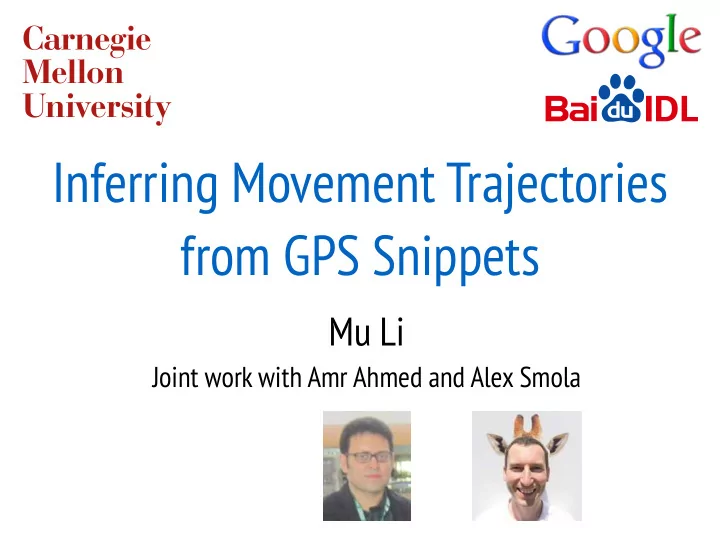

Carnegie Mellon University Inferring Movement Trajectories from GPS Snippets Mu Li Joint work with Amr Ahmed and Alex Smola
Motivation Every 2/3 has a smartphone/tablet nowadays, typically has GPS Not only learn the current position, but also predict where people will go, and when arrive It benefits mobile apps navigation shop, restaurant recommendation context-aware assistance contextual metadata
Challenges Data is big because of the huge amount of users trillions sequence, worldwide coverage Data is sparse due to energy and privacy constraints GPS sequence is short, only has several points Data is noisy inexact positions in city irrational path planing travel speeds vary
Model and Inference
Model n observed locations states paths Y p ( O, S | θ ) = p ( o k | s k , θ ) p ( s k +1 | s k , θ ) s 1 o 1 k =1 o 3 observation model motion model s 2 s 3 o 2 Observation model: ✓ � 2 ◆ − 1 1 � 2 − � o loc − s loc � � o dir − s dir � � � p ( o | s ) ∝ exp 2 σ 2 2 σ 2 d l Motion model: X p ( s 0 | s, θ ) = p ( ξ | s, θ ) p ( s 0 | s, ξ , θ ) ξ " n all possible paths # X Y p ( s 0 | s, ξ , θ ) = π ( i ι , i ι +1 ) ι =1 ξ from s to s’ along path ξ transition probability
Travel time of a road segment Histogram of speed and travel time 0.06 0.05 0.05 0.04 Frequency (%) Frequency (%) 0.04 0.03 0.03 0.02 0.02 0.01 0.01 0 0 0 0.1 0.2 0.3 0.4 0.5 0 5 10 15 20 Inverse Speed (s/m) Speed (m/s) Key observation: speed somewhat follows Gaussian, and travel time follows an inverse Gaussian (IG) distribution Time from s to s’ ~ IG(length/speed, 𝜀 2 . length 2 )
Travel time of a path We made two assumptions: the mean and variance of the speed for a path is a weighted linear combination of all road segments for a road segment is a weighted linear combination of all associated attributes ★ road type, #lanes, speed limit, location, time, etc…
Inference method Solve the non-convex optimization problem maximize π , ω , γ log p(O| π , ω , γ ), where O is the training data, π transition probability, ω and γ are coefficient about speed mean and variance Repeat until convergence randomly sample several GPS sequence run an optimized dynamic programming to update π update ω , γ by subgradient descent
Experiment
Setup Dataset SF Boston NYC Salina Road segment 18K 7K 17K 9K Intersection 35K 10K 29K 23K Trajectores 8M 7M 4M 3M Binary feature road features: road attributes such as major road/high way, number of lanes, speed limit temporal features: slice workday and weekend hours personalized speed: use trajectory ID as a feature
Predict the future ? •predict the position based on time •predict the travel time based on position 7 NYC 6 △ use GPS recored speed 5 SF Time error (sec) ☆ only use the shortest path 4 Boston 3 ☐ no personalized modeling 2 ○ the full model Salina 1 0 20 40 60 80 Location error (m)
Conclusion A joint model: map trajectory + predict time/position + model road speed/variance Focus on sparse, noise, and anonymous GPS sequence A simple yet powerful model and efficient inference method
Inference the past ? •inference the position based on time •inference the travel time based on position 7 △ use GPS recored speed 6 5 Time error (sec) ☆ only use the shortest path NYC 4 ☐ no personalized modeling 3 SF 2 ○ the full model Boston 1 Salina 0 20 40 60 80 Location error (m)
Recommend
More recommend